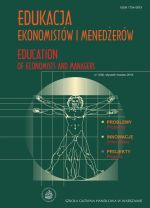Treść głównego artykułu
Abstrakt
The article presents theoretical assumptions of the relevance of measuring human capital in an enterprise, from a strategic perspective – the importance of the creation of value and an operational perspective – the importance in making personnel decisions. It also presents the main results of an empirical study on the information needs and tools currently used by companies for the measurement of human capital, carried out in the framework of the project “Human capital as part of the company’s value.” The study covered 600 enterprises of different sizes (micro, small, medium and large), representing various industries. Fragment of the study presented in the article focuses on the motivations of companies to make the analysis and measurement of human capital and the perceived benefits of this activity.
Szczegóły artykułu
Autor (Autorzy) artykułu oświadcza, że przesłane opracowanie nie narusza praw autorskich osób trzecich. Wyraża zgodę na poddanie artykułu procedurze recenzji oraz dokonanie zmian redakcyjnych. Przenosi nieodpłatnie na Oficynę Wydawniczą SGH autorskie prawa majątkowe do utworu na polach eksploatacji wymienionych w art. 50 Ustawy z dnia 4 lutego 1994 r. o prawie autorskim i prawach pokrewnych – pod warunkiem, że praca została zaakceptowana do publikacji i opublikowana.
Oficyna Wydawnicza SGH posiada autorskie prawa majątkowe do wszystkich treści czasopisma. Zamieszczenie tekstu artykuły w repozytorium, na stronie domowej autora lub na innej stronie jest dozwolone o ile nie wiąże się z pozyskiwaniem korzyści majątkowych, a tekst wyposażony będzie w informacje źródłowe (w tym również tytuł, rok, numer i adres internetowy czasopisma).
Osoby zainteresowane komercyjnym wykorzystaniem zawartości czasopisma proszone są o kontakt z Redakcją.
![]()
Referencje
-
1. Allee, V. (2007), Rethinking Value in the Knowledge Economy, Handbook of business strategy, Emerald Backfiles.
2. Alvarez Dardet, C., Cuevas Rodriguez G., Valle Cabrera R. (2000), Value Based Management: Performance Measurement Systems for Human Resources, “Journal of Human Resource Costing and Accounting”, Vol. 5, No. 1, Spring.
3. Bose, S., Oh, K.B. (2004), Measuring strategic value drivers for managing intellectual capital, “The Learning Organization”, Vol. 11 No. 4/5.
4. Boudreau, J.W., Ramstad, P.M. (2003), Strategic HRM Measurement in the 21st Century: From Justifying HR to Strategic Talent Leadership, in: M. Goldsmith, R.P. Gandossy & M.S. Efron (eds.), HRM in the 21st Century, John Wiley, New York.
5. Cascio, W., Boudreau, J. (2008), Investing in People. Financial Impact of Human Resource Initiatives, Pearson Education.
6. Gamerschlag, R. (2013), Value relevance of human capital information, “Journal of Intellectual Capital”, Vol. 14 No. 2.
7. Lawler, E.E., Levenson, A.R., Boudreau, J.W. (2004), HR Metrics and Analytics: Use and Impact, “HR. Human Resource Planning” 27, 4.
8. Lazear, E.P. (2000), The future of personnel economics, “Economic Journal”, Vol. 110.
9. Lazear, E.P., Gibbs, M. (2009), Personnel Economics in Practice, Wiley, New York.
10. Lazear, E.P., Shaw, K.L. (2007), Personnel Economics: the Economist’s View of Human Resources, National Bureau of Economic Research, Working Paper 13653 (http:// www.nber.org/papers/w13653)
11. Lipka, A. (2010), Inwestycje w kapitał ludzki organizacji w okresie koniunktury i dekoniunktury, Oficyna a Wolters Kluwer business.
12. Rulliere, J.L., Villeval, M.C. (2003), Personnel economics: theoretical perspectives and empirical evidence, “International Journal of Manpower”, Vol. 24, No. 7.
13. Sajkiewicz, A. (2001), Pracownicy jako wartość firmy, VII Kongres Ekonomistów Polskich, Zeszyt 14, PTE, Warszawa.
14. Vafaei, A., Taylor, D., Ahmed, K. (2011), The value relevance of intellectual capital disclo sures, “Journal of Intellectual Capital”, Vol. 12, No. 3.
15. Wright, P.M., Snell, S.A. (2005), Partner or guardian? HR’s challenge in balancing value and values, “Human Resource Management”, Vol. 44, No. 2.
16. Wyatt, A. (2008), What financial and non fínancial information on intangibles is value relevant? A review of the evidence, “Accounting and Business Research”, Vol. 38, No. 3.
Referencje
2. Alvarez Dardet, C., Cuevas Rodriguez G., Valle Cabrera R. (2000), Value Based Management: Performance Measurement Systems for Human Resources, “Journal of Human Resource Costing and Accounting”, Vol. 5, No. 1, Spring.
3. Bose, S., Oh, K.B. (2004), Measuring strategic value drivers for managing intellectual capital, “The Learning Organization”, Vol. 11 No. 4/5.
4. Boudreau, J.W., Ramstad, P.M. (2003), Strategic HRM Measurement in the 21st Century: From Justifying HR to Strategic Talent Leadership, in: M. Goldsmith, R.P. Gandossy & M.S. Efron (eds.), HRM in the 21st Century, John Wiley, New York.
5. Cascio, W., Boudreau, J. (2008), Investing in People. Financial Impact of Human Resource Initiatives, Pearson Education.
6. Gamerschlag, R. (2013), Value relevance of human capital information, “Journal of Intellectual Capital”, Vol. 14 No. 2.
7. Lawler, E.E., Levenson, A.R., Boudreau, J.W. (2004), HR Metrics and Analytics: Use and Impact, “HR. Human Resource Planning” 27, 4.
8. Lazear, E.P. (2000), The future of personnel economics, “Economic Journal”, Vol. 110.
9. Lazear, E.P., Gibbs, M. (2009), Personnel Economics in Practice, Wiley, New York.
10. Lazear, E.P., Shaw, K.L. (2007), Personnel Economics: the Economist’s View of Human Resources, National Bureau of Economic Research, Working Paper 13653 (http:// www.nber.org/papers/w13653)
11. Lipka, A. (2010), Inwestycje w kapitał ludzki organizacji w okresie koniunktury i dekoniunktury, Oficyna a Wolters Kluwer business.
12. Rulliere, J.L., Villeval, M.C. (2003), Personnel economics: theoretical perspectives and empirical evidence, “International Journal of Manpower”, Vol. 24, No. 7.
13. Sajkiewicz, A. (2001), Pracownicy jako wartość firmy, VII Kongres Ekonomistów Polskich, Zeszyt 14, PTE, Warszawa.
14. Vafaei, A., Taylor, D., Ahmed, K. (2011), The value relevance of intellectual capital disclo sures, “Journal of Intellectual Capital”, Vol. 12, No. 3.
15. Wright, P.M., Snell, S.A. (2005), Partner or guardian? HR’s challenge in balancing value and values, “Human Resource Management”, Vol. 44, No. 2.
16. Wyatt, A. (2008), What financial and non fínancial information on intangibles is value relevant? A review of the evidence, “Accounting and Business Research”, Vol. 38, No. 3.
